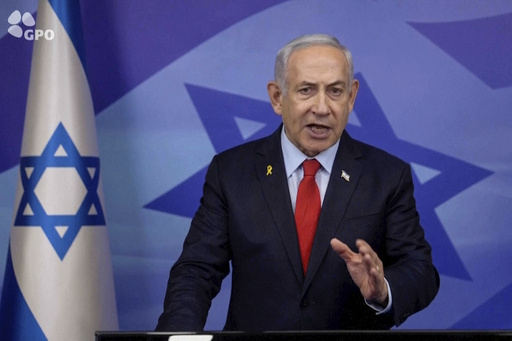
BEIRUT — Following a tumultuous month-long conflict in 2006 involving Israel and the formidable Hezbollah militant group in Lebanon, the United Nations Security Council reached a unanimous resolution aimed at halting the hostilities and achieving lasting security along the border.
However, while there was a sense of stability for nearly twenty years post-conflict, the stipulations set forth by Resolution 1701 were never fully activated.
Currently, discussions are focused on how to finally enforce this resolution as a part of a ceasefire agreement recently approved by Israel.
In late September, a series of low-intensity clashes escalated between Israel and Hezbollah, culminating in full-scale warfare and an Israeli ground offensive.
As Israeli aircraft carried out strikes deep within Lebanon and Hezbollah launched counterattacks into northern Israel, U.N. and diplomatic representatives revisited the 2006 resolution in an effort to resolve the ongoing crisis.
Despite years of polarized politics and geopolitical tensions in the region stalling meaningful progress on implementing the resolution, the international community still views it as the most promising approach for establishing long-term peace between Israel and Lebanon.
Almost two decades after the last significant conflict between the two sides, U.S.-led shuttle diplomacy has reopened channels for dialogue, leading Lebanon and Israel to agree on a ceasefire proposal that reaffirms commitment to the resolution, complete with a renewed implementation strategy.
What does UNSC Resolution 1701 entail?
In the year 2000, Israel withdrew its military presence from the majority of southern Lebanon, adhering to a U.N.-defined “Blue Line” that delineated the two nations, including portions of the Israeli-occupied Golan Heights, which are internationally recognized as Syrian territory.
As a result, U.N. peacekeeping forces, identified as UNIFIL, augmented their numbers in the vicinity of the withdrawal zone.
Resolution 1701 was designed to ensure that Israel completed this withdrawal and that Hezbollah would relocate north of the Litani River, allowing the Lebanese military and U.N. peacekeepers to exclusively control the area.
The resolution proposed the deployment of up to 15,000 U.N. peacekeepers to maintain order, facilitate the return of displaced persons in Lebanon, and bolster the Lebanese military’s presence in the region.
The overarching goal was to achieve sustained security, with intended future demarcation of land borders to address territorial disagreements.
Additionally, it reiterated previous demands for the disarmament of all armed factions within Lebanon, including Hezbollah.
“Initially, it was crafted for a specific situation,” remarked Elias Hanna, a retired general of the Lebanese army. “Yet over time, the significance of the resolution has diminished.”
Have the terms of Resolution 1701 been applied?
For years, Lebanon and Israel have exchanged accusations regarding numerous breaches of the tense border.
Israel claims that Hezbollah maintains an elite military unit, the Radwan Force, and has expanded its arsenal, alleging that the group misuses local environmental organizations for surveillance of its forces.
Conversely, Lebanon has voiced complaints about Israeli military aircraft and naval vessels encroaching on its air and maritime space independently of any active conflict.
“The role of UNIFIL has eroded over time like many other peacekeeping missions lacking a clear directive,” explained Joseph Bahout, director of the Issam Fares Institute for Public Policy at the American University of Beirut. “They cannot conduct inspections without coordinating with the Lebanese army.”
For years, UNIFIL has urged Israel to withdraw from various territories north of the established frontier, yet these calls have gone unheeded.
As the conflict continues, the peacekeeping mission has accused both Israel and Hezbollah of impeding its operations and jeopardizing its personnel and assets.
Hezbollah’s standing, meanwhile, has strengthened, with both its military assets and political clout within Lebanon significantly increasing.
Backed by Iran, Hezbollah has played a critical role in supporting Syrian President Bashar Assad amidst attempts to overthrow his regime and has also extended its influence to Iranian-supported factions in Iraq and Yemen.
The group reportedly possesses around 150,000 projectiles, including precision-guided munitions aimed at Israel, and has integrated drones into its arsenal.
Hanna emphasized that Hezbollah represents an unprecedented non-state entity with considerable military and political sway.
How do mediators plan to implement Resolution 1701 nearly twenty years later?
Israel’s security Cabinet recently approved a ceasefire agreement as announced by Prime Minister Benjamin Netanyahu’s office, with the truce expected to commence at 4 a.m. local time on Wednesday.
U.S. and French-led initiatives to secure a ceasefire between Israel and Hezbollah underline the belief that the resolution remains central to achieving peace.
For close to a year, Washington has advocated various iterations of a plan intended to facilitate a gradual pathway toward the full activation of the resolution.
International negotiators aspire to enhance financial backing for the Lebanese army—an entity not directly involved in the recent Israel-Hezbollah hostilities—enabling them to deploy an additional 6,000 troops south of the Litani River to help oversee the resolution’s enforcement.
This agreement includes the establishment of an international monitoring body, led by the United States, to supervise enforcement and verify the withdrawals of both Hezbollah and Israeli forces.
It remains uncertain how this committee will operate or address potential violations.
Circumstances today are significantly more complicated than those in 2006, prompting skepticism about the resolution’s effectiveness given the considerable shifts in political landscapes and power dynamics both regionally and within Lebanon itself.
“You’re connecting Resolution 1701 to a multitude of issues,” Bahout noted. “A resolution reflects the prevailing balance of power and political climate.”
With the ceasefire now in effect, there is hope that Israel and Lebanon can commence dialogues to define their territorial borders and resolve disputes surrounding various points along the Blue Line, fostering long-term security after many years of conflict and contention.
